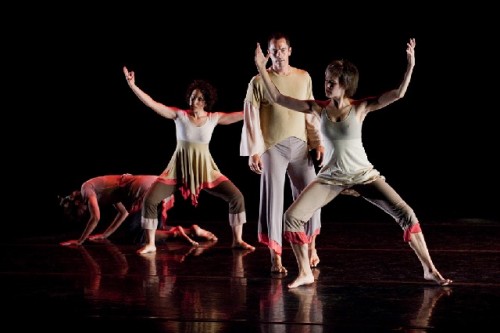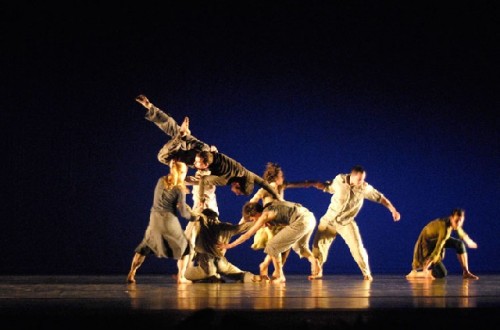Doug Varone and Dancers at Jacob's Pillow
Classics With Contemporary Variations
By: Charles Giuliano - Aug 15, 2009
Doug Varone and Dancers
Artistic Director, Doug Varone
Dancers: Julia Burrer, Daniel Charon, Ryan Corriston, Natalie Desch, Erin Owen, Alex Springer, Eddie Taketa, Netta Yerushalmy
Lighting Designers, Jane Cox, Joshua Epstein, Robert Wierzel; Costume Designer, Liz Prince; Technical Director, Tricia Toliver; Executive Director, Caterina Bartha
Jacob's Pillow
Ted Shawn Theatre
Becket, Mass.
August 12-16, 2009
Program
Castles
Choreography, Doug Varone; Music, Sergei Prokofiev "Waltz Suite, Opus 110"
Lighting Design, Jane Cox and Joshua Epstein; Costume Design, Liz Prince. Dancers: The Company
Short Story
Choreography, Doug Varone; Music, Sergei Rachmaninoff "Prelude in C;" Lighting Design, Ted Sullivan; Dancers, Daniel Charon and Natalie Desch.
Lux
Choreography, Doug Varone; Music, Philip Glass "The Light;" Lighting Design, Robert Wierzel; Costume Design, Liz Prince; Dancers: The Company
The company Doug Varone and Dancers has been performing since 1986. They reside in New York at the 92nd Street Y Harnkess Dance Center. The company has toured extensively earning numerous awards and commissions. Varone has choreographed for the Metropolitan Opera including new productions of "Le Sacre de Printemps" "Les Troyens" "Salome" and the world premiere of Tobias Picker's "An American Tragedy."
Other work in opera includes "Die Walkure" (Washington Opera); "Il Viaggio a Reims" (New York City Opera); and the American premieres of George Antheil's "Transatlantic" and Ian Gordon's debut productions of "Grapes of Wrath" (Minnesota Opera). Varone's extensive credits include work in dance, theatre, opera, film, television and fashion.
The audience last night, in the Ted Shawn Theater of Jacob's Pillow was clearly thrilled by the energy, versatility, variety and technical ability of a truly remarkable company. They offered a nicely selected program. The evening started with "Castles" to Prokofiev's "Waltz Suite, Opus 110" in six movements. After an intermission, there was a brief duet "Short Story" to Rackmaninoff's "Prelude in C." Followed by their signature work "Lux" set to a composition by Philip Glass "The Light."
The first work "Castles" set to a waltz, but with a more passionate Russian accent than the lighter touch of Vienna, started with the eight dancers on stage each under a thin beam of light. As the dance evolved through six movements there were many variations of ensembles, pairs, trios, and quartets. There were even aspects when the dancers held each other around the waist forming the kind of long row one associates with figure skating or a chorus line. They also introduced mime like gestures.
The company is noted for long sweeping, circular movements. The flow of these elements was seamless and the audience was always surprised by new variations and combinations. In the second movement, for example, there was an intriguing duet for male dancers, Daniel Charon, and Alex Springer. It evoked attraction, sensuality as well as conflict and competition. In the forth movement there was a more conventional mating dance between Natalie Desch and Eddie Taketa. These two dancers were often singled out in the choreography and richly deserved our special attention.
In "Short Story" the compact Desch, signified by blonde hair in a bouncy pony tail, partnered with Daniel Charon. They were attired in dark, silk shirts and pants. The brief dance to the percussive piano of Rachmaninoff's "Prelude in C" evoked a lover's quarrel. In one element they fall to the floor. She struggles to rise, then is pulled back down to him. This is repeated several times conveying a woman trying to break away from and end a relationship. It was a powerful and delicious piece the more poignant and evocative for its brevity.
After the two classically based works the dance set to Phillip Glass's hypnotic, circular, ostinato form "The Light" created a very different mode and look for the company. This was more dance than ballet. The black attired company seemed to twitter like creatures of the night, perhaps moths or bats. The mood of "Lux" or light was emphasized by the simple device of a circle of light that slowly rose like the moon through the course of the dance.
The choreography began and ended with remarkable solos by Eddie Takata. He revealed a wonderful vocabulary of quick, sharp, and precise movements that accented and punctuated the music. As is the case with a Glass score there is not the usual sense of an arc or movement with a beginning, middle and end. Rather it just ebbs, pulses and flows. There are the signature moments with trills of repeated notes on the synthesizer. This piece appeared to combine strings with electronic instruments. It is more complex, less minimalist and more evolved than his earlier music. But there were also incidents of false starts and endings. The dance appeared to be over only to pick up another cycle of movement.
It was a lighting effect that finally defined an end to the Glass piece. A strong spot was beamed directly down onto Taketa. He then conveyed emotionally charged gestures and movements reaching up into it. Rather like a moth to a flame. It was a stunning moment that evoked a standing ovation from the audience. One that was richly deserved and sustained as the entire company came on stage for their bows. It was a truly sensational evening of dance.





